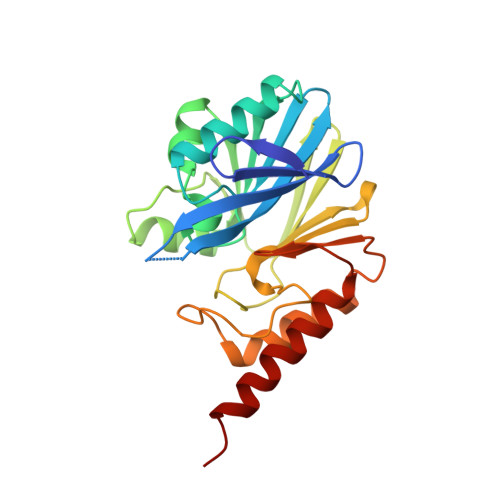Structural consequences of the active site substitution Cys181 --> Ser in metallo-beta-lactamase from Bacteroides fragilis.
Li, Z., Rasmussen, B.A., Herzberg, O.(1999) Protein Sci 8: 249-252
- PubMed: 10210203
- DOI: https://doi.org/10.1110/ps.8.1.249
- Primary Citation of Related Structures:
4ZNB - PubMed Abstract:
The metallo-beta-lactamases require divalent cations such as zinc or cadmium for hydrolyzing the amide bond of beta-lactam antibiotics. The crystal structure of the Zn2+ -bound enzyme from Bacteroides fragilis contains a binuclear zinc center in the active site. A hydroxide, coordinated to both zinc atoms, is proposed as the moiety that mounts the nucleophilic attack on the carbonyl carbon atom of the beta-lactam bond of the substrate. It was previously reported that the replacement of the active site Cys181 by a serine residue severely impaired catalysis while atomic absorption measurements indicated that binding of the two zinc ions remained intact. Contradicting data emerge from recent mass spectrometry results, which show that only a single zinc ion binds to the C181S metallo-beta-lactamase. In the current study, the C181S mutant enzyme was examined at the atomic level by determining the crystal structure at 2.6 A resolution. The overall structure of the mutant enzyme is the same as that of the wild-type enzyme. At the mutation site, the side chain of Ser181 occupies the same position as that of the side chain of Cys181 in the wild-type protein. One zinc ion, Zn1, is present in the crystal structure; however, the site of the second zinc ion, Zn2 is unoccupied. A water molecule is associated with Zn1, reminiscent of the hydroxide seen in the structure of the wild-type enzyme but farther from the metal. The position of the water molecule is off the plane of the carboxylate group of Asp103; therefore, the water molecule may be less nucleophilic than a water molecule which is coplanar with the carboxylate group.
Organizational Affiliation:
Center for Advanced Research in Biotechnology, University of Maryland Biotechnology Institute, Rockville 20850, USA.
















